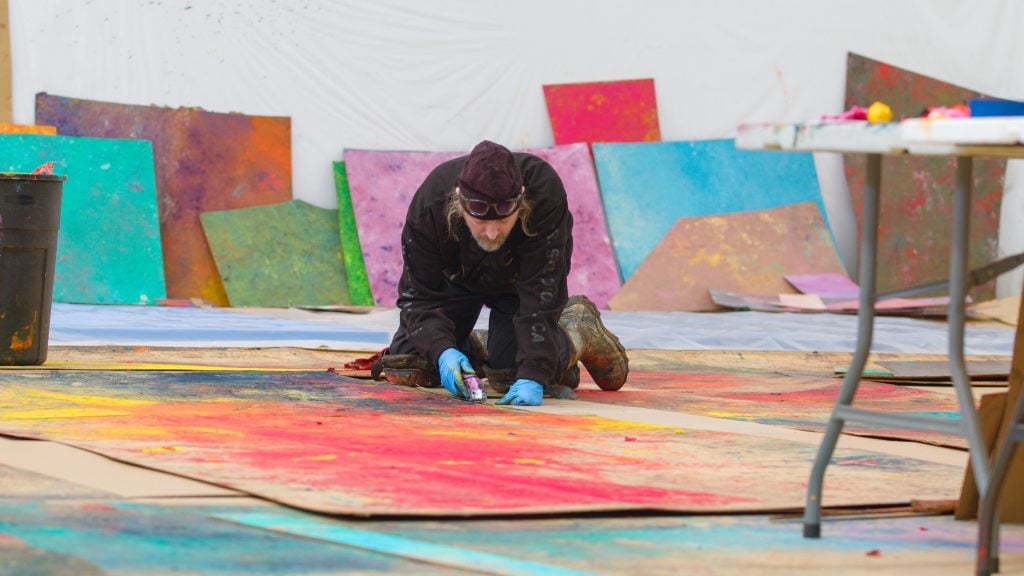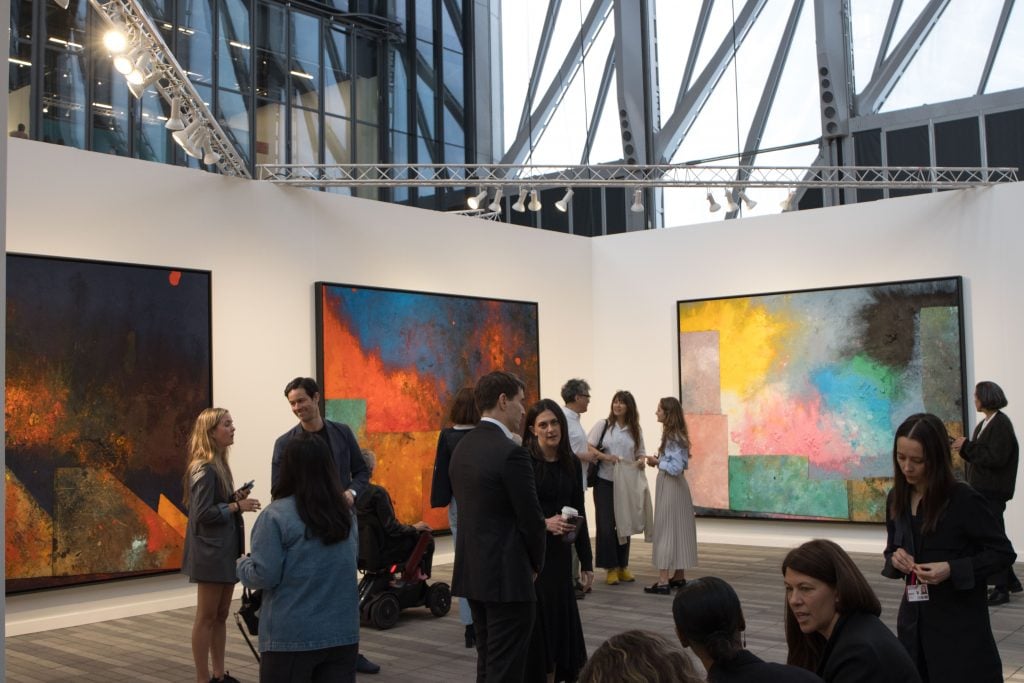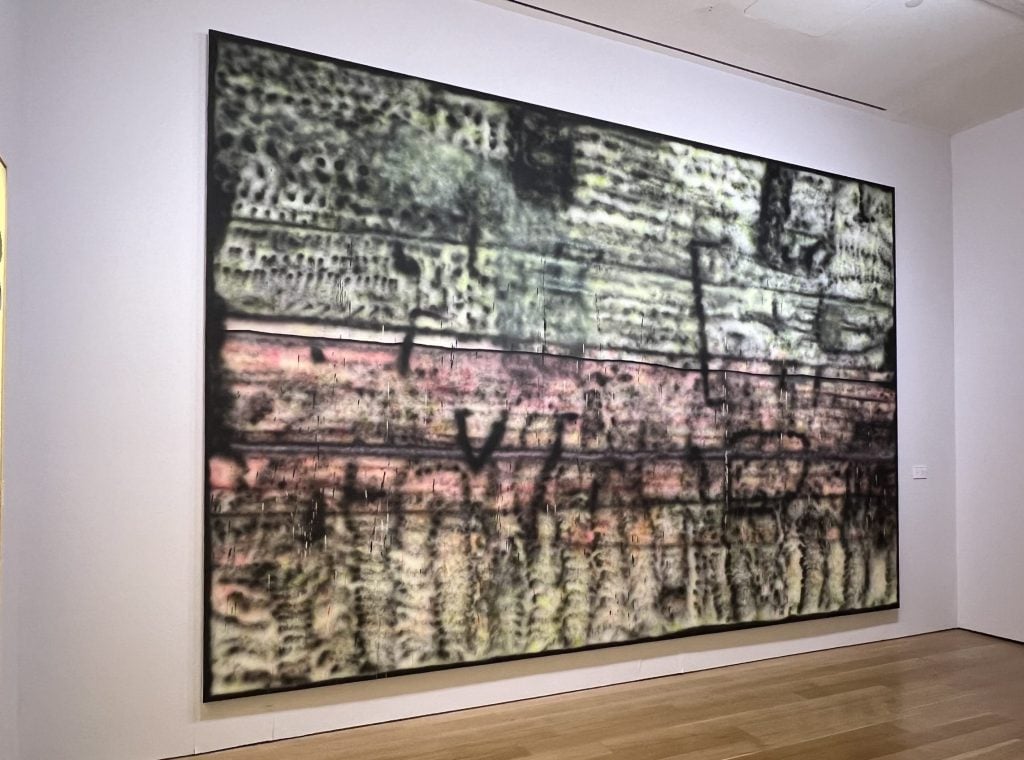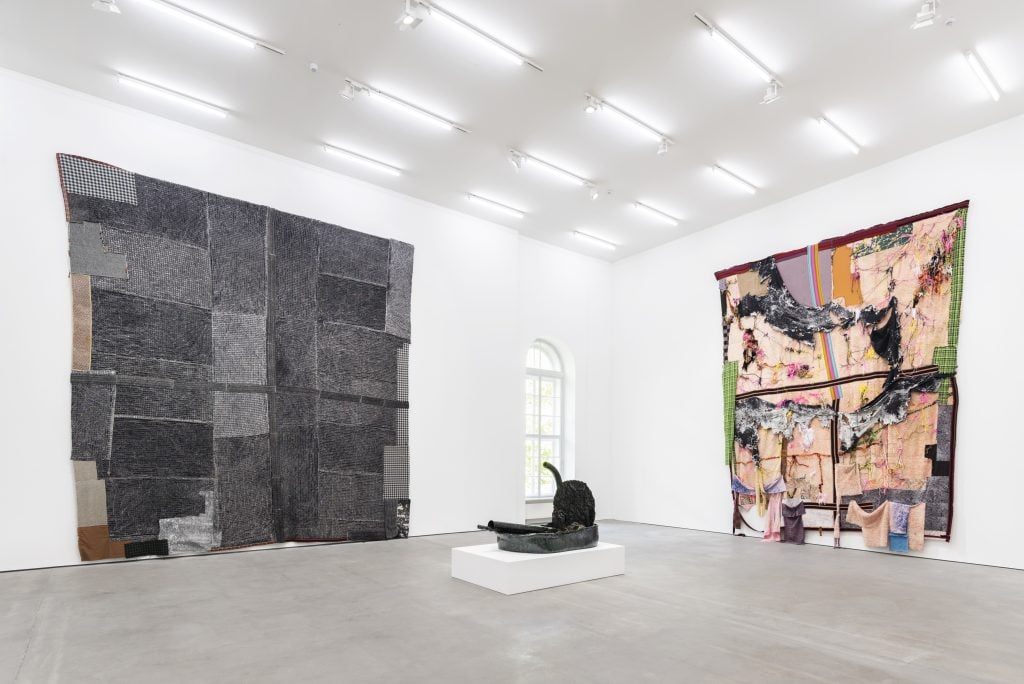The Art Detective
Sterling Ruby’s New Paintings Sold for $550,000 Each at Frieze New York. Are They Worth That?
The artist's market was once red hot, but auction results in recent years have been disappointing.

The artist's market was once red hot, but auction results in recent years have been disappointing.

Katya Kazakina

To understand the weirdness in the contemporary art market right now, you don’t have to look any further than Sterling Ruby.
Last week, four abstract paintings from Ruby’s “Turbine” series drew collectors to Gagosian gallery’s booth at Frieze New York. The muscular works feature cardboard elements and a fiery palette. They suggest speed and violence. And they are big: about 8 feet tall and 11 feet wide. Each had a price tag of $550,000, and all four sold by the fair’s end, according to the mega-gallery.
Two miles east, at Christie’s, an older and even bigger canvas from Ruby’s most coveted series—his spray painted works—went on view in a preview of art being sold from the Rosa de la Cruz Collection. When SP113 (2010) is offered later this month, it is estimated to sell for just $250,000 to $350,000.
Let me point out something: If you spent $550,000 on a brand new painting by Ruby last week, you paid more than anyone else did for a Ruby at auction in the past two years, according to the Artnet Price Database. Since 2018, only one person paid more than that at auction: the buyer of a massive, pink-hued spray painting, SP15 (2007), spending about $615,000 at Sotheby’s Hong Kong in 2021.

Sterling Ruby paintings at Gagosian’s Frieze New York booth. Photo by Elvin Tavarez.
I’ve written a lot lately about the disconnect between primary and secondary prices, where artworks cost more when they are new than when they are resold. Investment-grade art seems a lot less liquid than it used to be. Yet collectors still pay wild primary prices.
Ruby’s secondary (or resale) market has been rocky over the past decade, even as his career has soared. By most metrics, the 52-year-old is a very, very successful artist. He is represented by the biggest gallery in the world. He works in a studio in Los Angeles that is 110,000 square feet—large enough to house an airplane, along with massive paintings and various other creative pursuits, including sculpture, ceramics, textiles, and fashion.
But even as the prices for Ruby’s new artworks have risen, the size of his resale market has declined—by a whopping 80 percent over the past decade. Ruby’s annual auction sales peaked at $8 million in 2014, according to Artnet data. Last year, 39 works by Ruby generated just $1.7 million at auction. That is less than his $1.8 million auction record, which was set way back in 2013.
Now, if you have the money and wall space for one of those $550,000 paintings, and you are unconcerned about its resale value, God bless you. Enjoy!
But if you are putting your new “Turbine” painting in a warehouse, hoping that it will hold its value (or become more valuable), you may want to adjust your expectations.
‘A Classic Mid-Career Plateau’
There was a time when collectors could not get enough of Ruby’s spray paintings. These days, “if you get anyone to buy Sterling Ruby, it’s a success,” a collector told me. This is obviously an exaggeration (and not a kind one). But it does capture the growing awareness about a major shift that has taken place: the market has completely stopped for scores of once-successful artists.
Ruby’s champions say that auction numbers don’t tell the full story.
“This is the classic mid-career plateau,” said advisor Todd Levin, who considers Ruby to be one of the most important artists of his generation. “It’s normal for good artists.”
Levin, who has placed Ruby’s paintings with clients, sees such moments as opportunities “to hoover up” art, and he’s done just that many times over the years, snapping up material by key figures like John Baldessari, Robert Rauschenberg, Yayoi Kusama, and Louise Bourgeois when their markets went soft.
What makes Ruby’s situation especially tricky is what makes him such a significant and successful artist to begin with: his ambitious production, scale, and distribution network.

Sterling Ruby, SP113 (2010), which is being sold by the de la Cruz Collection at Christie’s. Photo: Katya Kazakina
Ruby’s paintings are very large. Let’s face it, most collectors are not like Rosa de la Cruz, who bought SP113 from the Pace gallery in 2010 for $155,000 knowing that her specially built Miami space could accommodate it (and plenty of other massive works). It’s more than 10 feet tall and 15 feet wide.
“It’s so large that it’s going to be a limiting factor,” Levin said of the work. “There’s no way this painting will fit into most apartment buildings.” Christie’s pre-sale estimates, $250,000 to $350,000, reflect this limitation, he added.
Ruby works in many different mediums, and at various price points, though the market places a premium on his large-scale spray-painted canvases. He’s also made richly glazed biomorphic ceramics, gargantuan poured-urethane sculptures that resemble stalagmites, nail polish drawings, collages, and even videos. In 2010, he placed a charred bus with blacked-out and spray painted windows inside Pace in New York.
“I have a pretty manic personality,” Ruby said in a 2020 video interview, explaining how he became an artist.
‘The Bloom Is Off the Rose’
Ruby has worked with numerous galleries over the years, starting with Foxy Production in New York in 2004, and then Metro Pictures, Marc Foxx, Taka Ishii, Sprüth Makers, Xavier Hufkens, Vito Schnabel, Pace, Hauser and Wirth, and Gagosian. While he was loyal to Foxy Production, which closed last year, he became notorious for jumping from one blue-chip firm to another. Every time, some frustrated collectors dumped his artworks at auction.
When Ruby was a hot, young artist, dealers told interested collectors that they had to give one painting to a museum if they wanted to buy one for their own collection, a practice known in the industry as BOGO (“buy one, give one”). They also told collectors to buy a lot of smaller works to prove their loyalty and get “to the front of the line” for what everyone wanted: those spray paintings.

Installation view of a Sterling Ruby exhibition at Sprüth Magers in Berlin in 2022. Photo: Ingo Kniest
“They were earning all these frequent flier miles,” one private dealer said. When the artist left the gallery, it was like the airline went “out of business.” Suddenly, they couldn’t use those hard-earned frequent fliers miles they had acquired by buying ashtrays, collages, and resin sculptures.
“I bought 18 Sterling Rubies,” the dealer said, explaining the dynamic. “I never wanted any of these things. I was just trying to get a spray painting.”
When Ruby departed, the old gallery no longer wanted to handle resales of the works it had sold clients because it no longer wanted to be involved with the artist. The new gallery wouldn’t touch them because it didn’t sell them and it would prioritize selling new works by the artist, a much more lucrative business (dealers typically receive 50 percent of the sale price).
With their frequent flier miles now worthless, collectors consigned lesser works to auction. When they didn’t perform well, the results placed pressure on Ruby’s market, pushing prices down, and, eventually, the spray paintings weren’t doing as well as they used to.
“The bloom is off the rose,” the dealer said. “The artist doesn’t look as solid anymore.”

Sculptures by Sterling Ruby included in the Saatchi Gallery’s exhibition “The Shape of Things to Come: New Sculpture” in 2011. Photo by Oli Scarff/Getty Images.
Last year, 28 percent of the 39 Rubys offered at auction failed to sell, with several paintings among the casualties. Just four lots fetched more than $100,000, according to Artnet data.
That, apparently, did not deter Ruby’s buyers at Frieze.
“The response to our solo presentation of new works by Sterling Ruby was tremendous,” said Serena Cattaneo Adorno, a senior director at Gagosian. “We placed all four paintings from the ‘Turbine’ series with important collectors, including two that are new to the gallery.”
The gallery declined to comment if it offered clients any discounts, which has become a popular way to motivate buyers without lowering “official” prices in the current market contraction.
Like many collectors and advisors, Christie’s is hoping that the downward spiral in Ruby’s secondary market can be reversed. In October, a 2009 spray painting, SP85, from the collection of Anne and Wolfgang Titze, fetched €453,600 ($480,000), solidly within its estimated range of €300,000 to €500,000.
“We really felt something shift in Sterling’s market, and it feels like more collectors are looking and relooking at his paintings,” said Sara Friedlander, Christie’s head of postwar and contemporary art. “Rosa had A+ examples of many artists and her spray painting is no exception. I’d buy it if I could!”